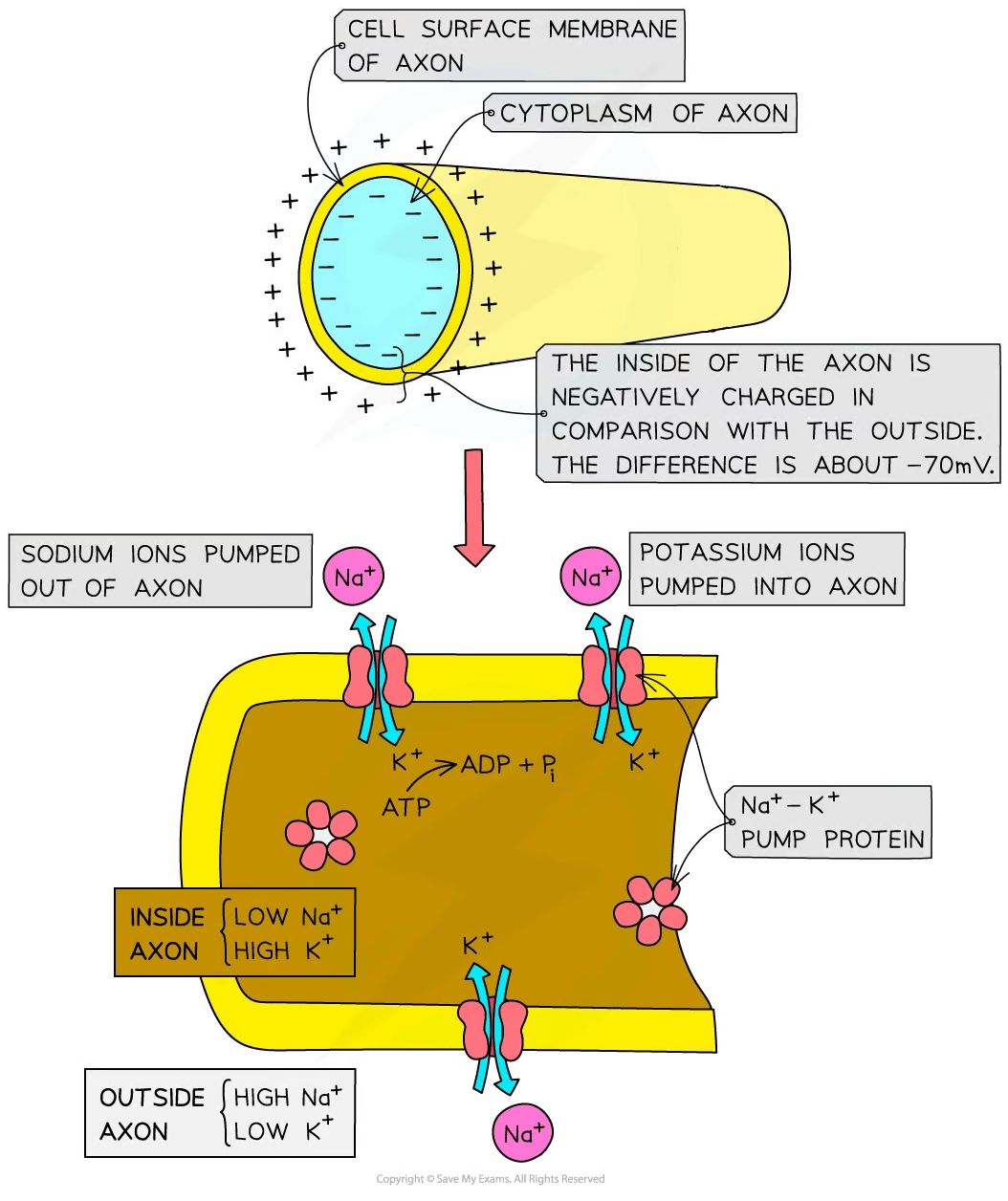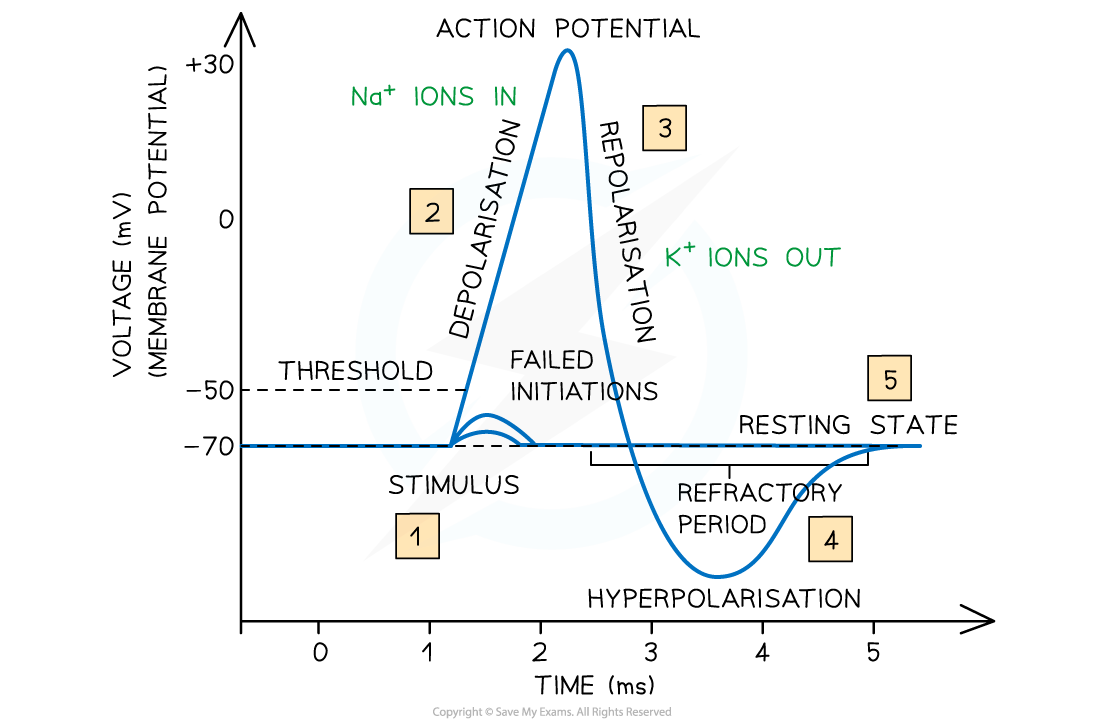Transmission of Nerve Impulses (Cambridge (CIE) A Level Biology): Revision Note
Exam code: 9700
Transmission of nerve impulses
Neurones transmit electrical impulses, which travel extremely quickly along the neurone cell surface membrane from one end of the neurone to the other
Unlike a normal electric current, these impulses are not a flow of electrons
These impulses, known as action potentials, occur via very brief changes in the distribution of electrical charge across the cell surface membrane
Action potentials are caused by the rapid movement of sodium ions and potassium ions across the membrane of the axon
Resting potential
In a resting axon (one that is not transmitting impulses), the inside of the axon always has a slightly negative electrical potential compared to the outside of the axon
This potential difference is usually about -70mV (i.e. the inside of the axon has an electrical potential about 70mV lower than the outside)
This is called the resting potential
Several factors contribute to maintaining the resting potential:
Factor | How the factor contributes to maintaining the resting potential |
|---|---|
Sodium-potassium pumps in the axon membrane | These pumps move sodium ions (Na+) out of the axon and potassium ions (K+) into the axon The pump proteins use the energy from the hydrolysis of ATP to continue moving these ions against their concentration gradients |
Many large, negatively charged molecules (anions) inside the axon | This attracts potassium ions, reducing the chance of them diffusing out of the axon |
Impermeability of the axon membrane to ions | Sodium ions cannot diffuse through the axon membrane when the neurone is at rest |
Closure of voltage-gated channels (required for action potentials) in the axon membrane | Stops sodium and potassium ions diffusing through the axon membrane |

Action potentials
There are channel proteins in the axon membrane that allow sodium ions or potassium ions to pass through
These open and close depending on the electrical potential (or voltage) across the axon membrane and are known as voltage-gated channel proteins (they are closed when the axon membrane is at its resting potential)
When an action potential is stimulated (eg. by a receptor cell) in a neurone, the following steps occur:
Sodium channel proteins in the axon membrane open
Sodium ions pass into the axon down the electrochemical gradient (there is a greater concentration of sodium ions outside the axon than inside. The inside of the axon is negatively charged, attracting the positively charged sodium ions)
This reduces the potential difference across the axon membrane as the inside of the axon becomes less negative – a process known as depolarisation
This triggers voltage-gated sodium channels to open, allowing more sodium ions to enter and causing more depolarisation
This is an example of positive feedback (a small initial depolarisation leads to greater and greater levels of depolarisation)
If the potential difference reaches around -50mV (known as the threshold value), many more channels open and many more sodium ions enter causing the inside of the axon to reach a potential of around +30mV
An action potential is generated
The depolarisation of the membrane at the site of the first action potential causes current to flow to the next section of the axon membrane, depolarising it and causing sodium ion voltage-gated channel proteins to open
The 'flow' of current is caused by the diffusion of sodium ions along the axon from an area of high concentration to an area of low concentration
This triggers the production of another action potential in this section of the axon membrane and the process continues
In the body, this allows action potentials to begin at one end of an axon and then pass along the entire length of the axon membrane

Repolarisation and the refractory period
Very shortly (about 1 ms) after an action potential in a section of axon membrane is generated, all the sodium ion voltage-gated channel proteins in this section close, stopping any further sodium ions diffusing into the axon
Potassium ion voltage-gated channel proteins in this section of axon membrane now open, allowing the diffusion of potassium ions out of the axon, down their concentration gradient
This returns the potential difference to normal (about -70mV) – a process known as repolarisation
There is actually a short period of hyperpolarisation
This is when the potential difference across this section of the axon membrane briefly becomes more negative than the normal resting potential
The potassium ion voltage-gated channel proteins then close and the sodium ion channel proteins in this section of the membrane become responsive to depolarisation again
Until this occurs, this section of the axon membrane is in a period of recovery and is unresponsive
This is known as the refractory period

Examiner Tips and Tricks
During the refractory period, a section of the axon is unresponsive. This is very important as it ensures that ‘new’ action potentials are generated after, rather than before or during the original action potential. This makes the action potentials discrete events and means the impulse can only travel in one direction. This is essential for the successful and efficient transmission of nerve impulses along neurones.

Unlock more, it's free!
Did this page help you?